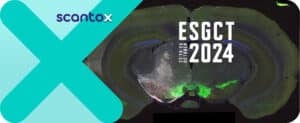Register Now: Encore Webinar on Ames-positive results on April 9th, 2025
Due to overwhelming interest in our SOT 2025 presentation, Scantox will host an expanded webinar on navigating Ames-positive results in small molecule drug development. Register here to secure your spot at “Navigating Ames-Positive Results: Regulatory Guidance, Practical Considerations and Strategic Approaches” on April 9th, 2025.
Introduction: When Mutagenicity Threatens Development Timelines
The discovery of an Ames-positive result during drug development can halt progress, potentially costing sponsors millions in development costs and critical timeline delays. At this year’s Society of Toxicology (SOT) Annual Meeting, this high-stakes challenge took center stage during an Exhibitor-Hosted presentation delivered by Matt Tate, PhD, Managing Director of Gentronix, part of Scantox Group. The packed session highlighted practical, experience-based approaches to navigating mutagenicity concerns that might otherwise derail promising therapeutic candidates.
“When a compound shows mutagenic potential in the Ames test, it understandably raises concern among development teams,” noted Tate. “But with strategic follow-up testing and regulatory engagement, there are often pathways forward that weren’t available even five years ago.”
This article outlines key themes from that session and places them in the context of broader genetic toxicology trends discussed at SOT 2025, offering actionable strategies for drug development scientists and regulatory specialists aligned with the 2024 Federal Drug Administration’s (FDA) 2024 draft guidance on follow-up testing strategies for Ames-positive small molecule drugs.
Context: What the FDA Draft Guidance on Ames-Positive Results Covers
The November 2024 FDA draft guidance “Recommended Follow-Up Testing for an Ames-Positive Drug (Active Ingredient) or Metabolite To Support First-in-Human Clinical Trials With Healthy Subjects” outlines a structured decision-making pathway for new small molecule drugs or metabolites that test positive in the Ames test. It specifically applies to:
- Small molecule active pharmaceutical ingredients (APIs) and their metabolites
- FIH trials involving healthy subjects
It does not apply to:
- Biologics
- Oncology indications (where trials start in patients)
- DNA-reactive impurities (covered under ICH M7)
Frequently Asked Questions About Ames-Positive Results
Q: Does an Ames-positive result automatically disqualify a compound from development?
A: Not necessarily. With a scientifically sound follow-up testing strategy, and clear mechanistic understanding, an Ames-positive compound may still proceed—particularly when the overall weight-of-evidence supports a low risk to humans.
Q: What follow-up assays are suggested by regulatory agencies after an Ames-positive finding?
A: The recommended sequence includes:
- Investigate possible test artifacts or structure-based concerns
- Conduct in vitro mammalian cell gene mutation assay (Mouse Lymphoma Assay (MLA) or HPRT)
- If in vitro is negative, proceed to in vivo gene mutation assay (Pig-A assay or transgenic rodent mutation assays)
Strategic Considerations for Ames-Positive Results Presented at SOT 2025
The presentation addressed a persistent challenge in pharmaceutical development: addressing Ames-positive results for active pharmaceutical ingredients (APIs) or impurities. Regulatory scrutiny around genotoxicity has intensified in recent years, particularly following high-profile nitrosamine impurity contamination issues that prompted extensive impurity qualification requirements.
“The 2024 FDA draft guidance sets out a pathway for how sponsors should approach follow up testing for Ames-positives,” Tate explained. “Utilizing in vitro and in vivo testing approaches alongside mechanistic and analytical determination of why the Ames test was positive enables sponsors to de-risk the hazard.”
Tate emphasized the importance of a science-led, stepwise approach:
- Mechanistic understanding: Review the Ames-positive result in context. Is the outcome linked to oxidative stress, metabolic activation, or a non-human-relevant pathway?
- Selection of follow-up assays: FDA allows use of either MLA or HPRT for in vitro follow-up. A negative result may justify proceeding to TGR or Pig-a assays.
- Designing in vivo studies: Adequate systemic and tissue exposure confirmation is expected. TGR assays can be supplemented with Pig-a endpoints to limit animal use.
Importantly, even if all follow-up results are negative, the FDA does not guarantee clearance to proceed. The agency expects a coherent weight-of-evidence argument and may still require disclosure of risk in informed consent forms submitted with the Investigational New Drug application (IND).
Drawing on both regulatory documentation and real-world study experience, the session outlined critical strategic considerations:
- Current regulatory expectations: The expected testing strategy from FDA to assess how the risk of an Ames-positive translate to the human clinical population
- Testing strategy selection: Review the Ames data for demonstrable mitigations. Or where mitigations are not evidenced, use of in vitro gene mutation assessments and in vivo transgenic rodent studies to mitigate risk
“The generation of an Ames-positive is a significant finding and risk to progressing a drug candidate to the clinic,” emphasized Tate. “Expert scientific support and this draft regulatory guidance opens a pathway to navigate Ames-positive challenges and still progressing such compounds to the clinic .”
Industry Pressure Points: Navigating Uncertainty
The session highlighted several critical challenges currently facing drug development teams:
Preserving Viable Candidates
As discovery and early development timelines tighten under constrained resources, optimizing decision-making around mutagenicity findings has become strategically important. Knowing when to advance versus discontinue compounds based on Ames results directly affects R&D efficiency.
Identifying the Underlying Cause
When a sponsor chooses to pursue development of an Ames-positive compound, the first step is understanding the reason behind the result. Structural alerts, known impurities, or degradants may provide context for mechanistic evaluation and guide follow-up testing.
Interpreting Test System-Specific Factors
Some Ames-positive results may arise from bacterial-specific conditions or metabolism not relevant to human biology. Understanding these nuances—such as test system artifacts or reactive intermediates not present in vivo—can help identify valid mitigating explanations.
Expertise Scarcity
There is a recognized shortage of genetic toxicology specialists across both industry and regulatory agencies. Successfully navigating an Ames-positive result requires expert interpretation and strategic study planning, making experienced consultation increasingly valuable.
Interpretation Variability
Differences persist in how regulatory agencies evaluate borderline or equivocal genotoxicity results. This variability adds complexity to regulatory submissions and reinforces the need for CRO and regulatory affairs partners with strong expertise in study design, interpretation, and communication.
Scientific Questions That Drive Decision-Making
The discussion following the presentation centered on practical scientific considerations that inform strategic planning:
- How sensitive is the Ames test for the presence of mutagenic impurities that could be driving the “adverse” Ames-positive result?
- How should the in vitro follow-up gene mutation assays like HPRT or MLA be weighted in terms of scientific validity and regulatory acceptance?
- When is the Pig-a gene mutation assay an appropriate alternative to transgenic rodent models?
- What role, if any, does the in vivo comet assay have in such follow ups?
- What factors influence regulatory flexibility when evaluating comprehensive weight-of-evidence arguments?
- How can sponsors efficiently implement the risk assessment procedures outlined in the FDA’s 2024 guidance?
- What opportunities exist to incorporate next-generation sequencing data into mutagenicity assessment frameworks?
Extending the Conversation: Upcoming Webinar Opportunity
Given the overwhelming response to the live session, an encore webinar is scheduled to expand on these critical topics and provide additional case examples. The follow-up will allow for more comprehensive Q&A.
Topics will include:
- What an Ames-positive result means and how to investigate it
- Selection and justification of follow-up assays
- Study design considerations for in vivo assays based on recent regulatory interactions
“We’re focused not just on what guidance documents say,” Tate noted, “but also on how these challenges are playing out in practice—how to design the right studies, and how to communicate those results to regulators.”
Key Takeaways for Drug Development Teams
For teams currently working with potentially mutagenic compounds or impurities, several actionable insights emerged:
- Early engagement is critical – Incorporate genotoxicity screening early in candidate selection to identify potential issues before significant investment
- Context matters – Identifying potential causes of Ames-positive results, or lack thereof, significantly informs follow-up actions
- Mechanism drives strategy – Understanding the mechanistic basis for positive findings can inform the most appropriate follow-up testing approach
- Experience guides success – Partners with extensive regulatory testing experience provide invaluable strategic guidance to sponsors with Ames-positive challenges
Conclusion: A Path Forward Through Scientific Strategy
The session made abundantly clear that Ames-positivity no longer represents an automatic development dead-end. With strategic regulatory genotoxicity testing selection, experienced regulatory guidance, and a comprehensive scientific approach, promising compounds flagged for mutagenicity can be evaluated more rationally—and advanced when appropriate.
Ready to learn more? Register now for our April 9th, 2025 webinar on navigating Ames-positive results.
The upcoming webinar will offer a practical, science-driven overview of how to apply the draft guidance in real-world settings. Whether you’re working in discovery, nonclinical, or regulatory affairs, this session offers a timely and targeted opportunity to align your strategy.










